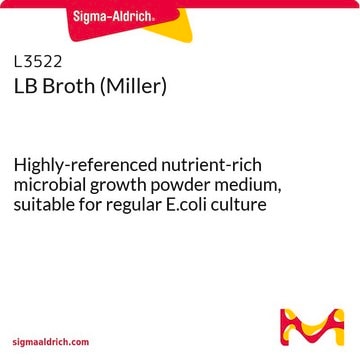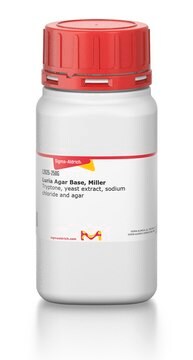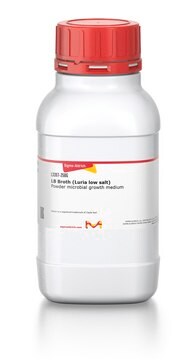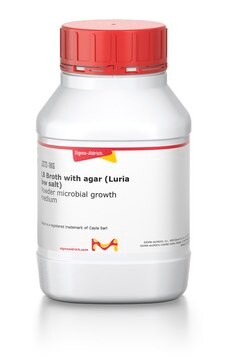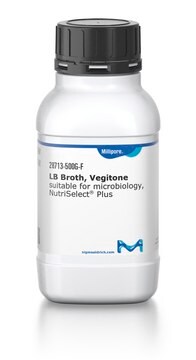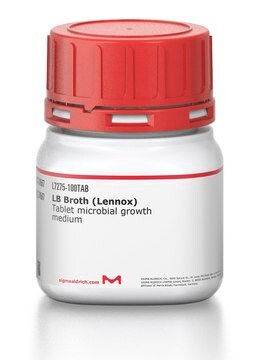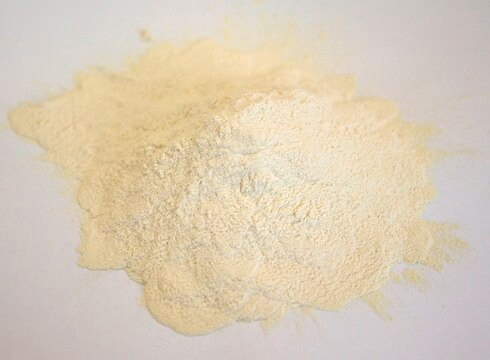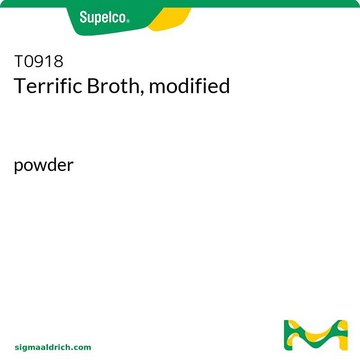L1900
Luria broth base, Miller′s modified
Tryptone, yeast extract and sodium chloride
Sinônimo(s):
Lennox broth base, modified, Luria-Bertani broth base, modified, Lysogeny broth base, modified
Faça loginpara ver os preços organizacionais e de contrato
About This Item
Código UNSPSC:
41106200
NACRES:
NA.72
Produtos recomendados
Formulário
powder
técnica(s)
microbiological culture: suitable
aplicação(ões)
agriculture
microbiology
Descrição geral
Luria broth (LB) is a nutritionally rich bacterial culture medium that is commonly used for maintaining and cultivating laboratory recombinant strains of E. coli. It has potential applications in molecular microbiology methods such as the preparation of plasmid DNA and recombinant proteins. Luria broth base, Miller′s modified is used to culture members of the family Enterobacteriaceae and for coliphage plaque assays.
Aplicação
Luria broth base, Miller′s modified has been used as a nutrient culture medium for E-coli cells.
Luria broth base (LB), Miller (L1900) is a bacteria growth mixture of sodium chloride (0.5g/L); tryptone (10g/L) and yeast extract (5g/L) typically combined with agar (15g/L).
Luria broth base (LB), Miller (L1900) is a bacteria growth mixture of sodium chloride (0.5g/L); tryptone (10g/L) and yeast extract (5g/L) typically combined with agar (15g/L).
Componentes
Contains: Tryptone, yeast extract and sodium chloride.
Reconstituição
Recommended use at 15.5 g per liter.
Código de classe de armazenamento
10 - Combustible liquids
Classe de risco de água (WGK)
WGK 3
Ponto de fulgor (°F)
Not applicable
Ponto de fulgor (°C)
Not applicable
Escolha uma das versões mais recentes:
Já possui este produto?
Encontre a documentação dos produtos que você adquiriu recentemente na biblioteca de documentos.
Os clientes também visualizaram
Erik Benson et al.
Nature, 523(7561), 441-444 (2015-07-24)
It was suggested more than thirty years ago that Watson-Crick base pairing might be used for the rational design of nanometre-scale structures from nucleic acids. Since then, and especially since the introduction of the origami technique, DNA nanotechnology has enabled
Xiaoyun Qiu et al.
Applied and environmental microbiology, 70(11), 6435-6443 (2004-11-06)
We systematically investigated the physiological response as well as DNA damage repair and damage tolerance in Shewanella oneidensis MR-1 following UVC, UVB, UVA, and solar light exposure. MR-1 showed the highest UVC sensitivity among Shewanella strains examined, with D37 and
C Niu et al.
Applied and environmental microbiology, 70(12), 6951-6956 (2004-12-03)
The specific biofilm formation (SBF) assay, a technique based on crystal violet staining, was developed to locate plant essential oils and their components that affect biofilm formation. SBF analysis determined that cinnamon, cassia, and citronella oils differentially affected growth-normalized biofilm
Anthony S Danko et al.
Applied and environmental microbiology, 70(10), 6092-6097 (2004-10-07)
Pseudomonas putida strain AJ and Ochrobactrum strain TD were isolated from hazardous waste sites based on their ability to use vinyl chloride (VC) as the sole source of carbon and energy under aerobic conditions. Strains AJ and TD also use
Daria Julkowska et al.
Journal of bacteriology, 187(1), 65-76 (2004-12-17)
The natural wild-type Bacillus subtilis strain 3610 swarms rapidly on the synthetic B medium in symmetrical concentric waves of branched dendritic patterns. In a comparison of the behavior of the laboratory strain 168 (trp) on different media with that of
Nossa equipe de cientistas tem experiência em todas as áreas de pesquisa, incluindo Life Sciences, ciência de materiais, síntese química, cromatografia, química analítica e muitas outras.
Entre em contato com a assistência técnica